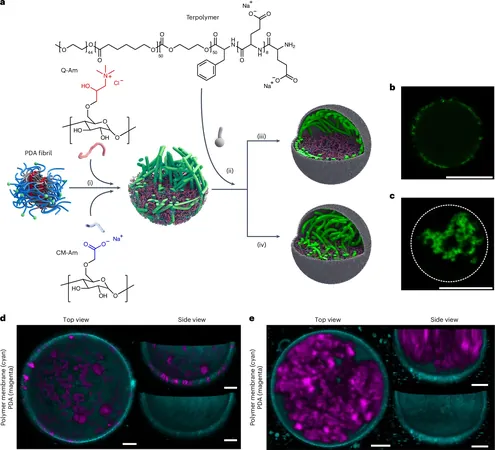
Revolutionary Polymer-Based Cytoskeleton Brings Artificial Cells Closer to Life
2025-01-07
Author: Sarah
Introduction
In an astounding breakthrough that blurs the lines between artificial and living cells, researchers from Eindhoven University of Technology (TU/e) have engineered a polymer-based network that mimics the cytoskeleton of real cells. This novel approach could revolutionize drug development and disease research by providing a more accurate model of cellular responses to mechanical forces.
The Importance of Cytoskeletons
Just as humans have a skeletal framework for structural support and stability, every cell boasts a cytoskeleton that ensures mechanical resilience. Traditional artificial cells, however, have lacked this vital structure, limiting their potential for biomedical applications. Now, the TU/e team has successfully integrated a cytoskeleton within artificial cells, significantly enhancing their functionality and enabling precise studies on how cells respond to external forces.
Research Publication
Published in the esteemed journal *Nature Chemistry*, this groundbreaking research highlights the importance of cytoskeletons in cell mechanics. 'This development not only has fundamental scientific implications but is also crucial for effective drug screening, innovative drug delivery technologies, and advancements in tissue regeneration,' noted Professor Jan van Hest from the Department of Chemical Engineering and Chemistry and the Department of Biomedical Engineering.
Advantages of Artificial Cells
Artificial cells have emerged as a sophisticated tool for understanding biological processes without the ethical and practical complexities of working with living tissues. They offer an environment free from the variables present in natural cells, making them ideal for studying the interactions of different molecules and their effects on cellular functions.
Limitations of Traditional Models
Until now, the focus has primarily been on replicating the basic functionalities of living cells, including communication and movement. Yet, most artificial versions have missed a crucial aspect: the cytoskeleton. The researchers pointed out that without this feature, it becomes a challenge to analyze how mechanical forces influence cellular activity.
Composition of the Cytoskeleton
The cytoskeleton itself is composed of polymers, contrasting with the bone structure of the human skeleton. While our bones number around 206 and serve multiple functions, the basic building blocks of a cytoskeleton are microtubules and microfilaments made from tubulin and actin proteins, respectively. These microscopic components enable cells to maintain shape, assist in transport, and play a key role in cell division.
Collaboration and Development Process
To create the artificial cytoskeleton, van Hest's team collaborated with colleagues from the Max Planck Institute in Erlangen, Germany. They designed a cytoskeletal structure using polydiacetylene (PDA), a polymer that captures essential characteristics of a natural cytoskeleton. It provides stiffness and flexibility, allowing for realistic mechanical responses similar to actual mammalian cells.
Research Findings
The implications of this innovation are enormous. By employing real-time deformability cytometry, a technique developed with assistance from German scientists Jochen Guck and Felix Reichel, researchers measured how their artificially constructed cells reacted when subjected to physical stress. They discovered that incorporating the PDA-based cytoskeleton made the cells stiffer, revealing that their compressive properties closely matched those of certain types of human cells.
Future Prospects
The future holds even more promise. This cytoskeleton advancement allows researchers to explore how artificial cells can interact chemically and mechanically with living cells, paving the way for new approaches in medicine, particularly in modulating immune responses.
Dedication to a Colleague
Additionally, this research has personal significance for van Hest, who dedicated the study to his late colleague Henk Janssen, a prominent figure in the project. With a rich legacy in synthetic organic chemistry, Janssen's mentorship played a vital role in the team's success.
Conclusion
As science continues to push the boundaries of what's possible, the integration of a cytoskeleton into artificial cells marks a significant leap toward creating life-like models for advanced biomedical applications. This groundbreaking work not only enhances our understanding of cellular mechanics but also lays the foundation for innovative solutions in healthcare.

 Brasil (PT)
Brasil (PT)
 Canada (EN)
Canada (EN)
 Chile (ES)
Chile (ES)
 Česko (CS)
Česko (CS)
 대한민국 (KO)
대한민국 (KO)
 España (ES)
España (ES)
 France (FR)
France (FR)
 Hong Kong (EN)
Hong Kong (EN)
 Italia (IT)
Italia (IT)
 日本 (JA)
日本 (JA)
 Magyarország (HU)
Magyarország (HU)
 Norge (NO)
Norge (NO)
 Polska (PL)
Polska (PL)
 Schweiz (DE)
Schweiz (DE)
 Singapore (EN)
Singapore (EN)
 Sverige (SV)
Sverige (SV)
 Suomi (FI)
Suomi (FI)
 Türkiye (TR)
Türkiye (TR)
 الإمارات العربية المتحدة (AR)
الإمارات العربية المتحدة (AR)